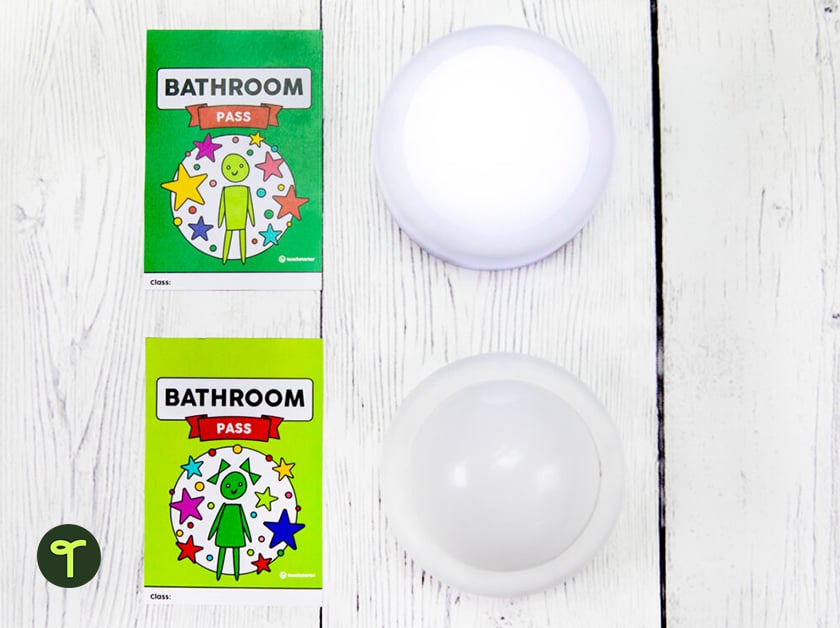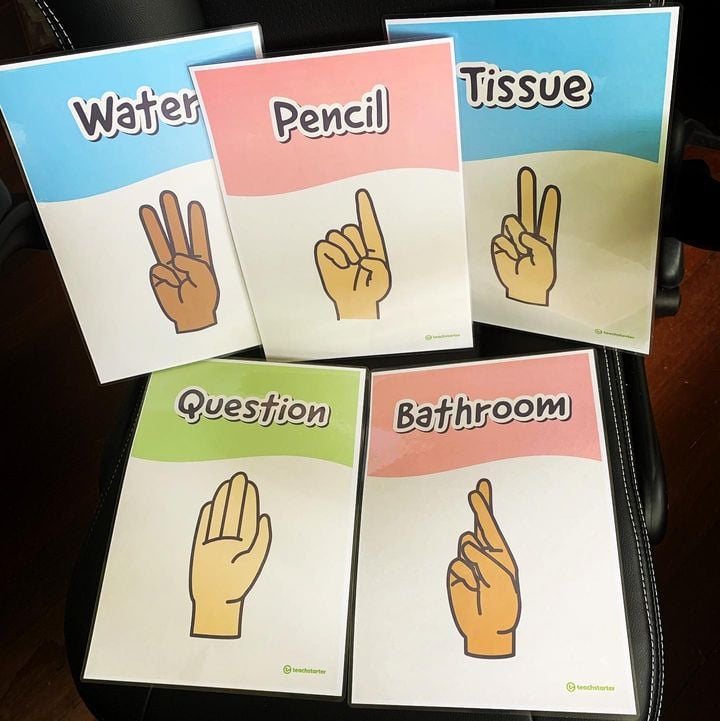How do you create bathroom rules for your classroom that fairly balance that need to go with the need for kids to be in the classroom for instruction? And what do the laws say about bathroom rights for students?
These are questions we hear regularly from teachers — after all, students are constantly asking to go to the bathroom, interrupting their classmates and missing class time, and there’s not a lot of good guidance out there for teachers. The school restroom may be a favorite escape for students who want to avoid classwork, but we’re well aware that kids need bathroom breaks during the day for their health. So how do you balance their health against those disruptions?
The teachers on the Teach Starter team have all had to walk that delicate line between ensuring students have potty breaks to relieve themselves and making sure kids don’t abuse the privilege of ducking out of class.
We’ve taken a deep look at the laws on the books in the US, plus we pulled out some of the bathroom rules that have worked in our own elementary and middle school classrooms to create this bathroom break guide for you. Read on for ideas for ideas bathroom rules for your classroom plus what the law says about how often kids need to use the bathroom in school.
How Often Should a Child Use the Bathroom?
Before you can even think about crafting rules for your class on how often they are allowed to use the school bathroom, it’s worth looking at what’s normal for kids in elementary school. While the number of times they have to head to the potty will vary based on age — a kindergarten student will likely need to urinate more frequently than a 4th-grade student, for example — and how much liquid they take in during the day, it’s generally accepted by medical experts that kids will need to pee at least every 2 to 3 hours.
Suppose you’re teaching upper elementary or middle school. In that case, that number may increase at certain times of the month for female students as they are often experiencing their menstrual cycles for the first time and may need to make more frequent trips to the bathroom to handle changing pads or simply to settle nerves about what’s going on with their bodies.
You’ll also want to be cognizant of students’ individual health when you’re considering if a bathroom break is warranted. This is an important bodily function, and recognizing that is an important part of preserving students’ dignity.

When the Society for Women’s Health Research (SWHR) surveyed school nurses about school bathroom policies back in 2019, they found that just 8 percent of schools had written policies, and their health experts sounded the alarm on the matter.
As Rebecca Nebel, PhD, SWHR’s director of scientific programs, said at the time, “Restricting access to the bathroom forces students into unhealthy toileting habits, such as holding in urine, which may create health problems that will follow students into adulthood and decrease their quality of life.”
Bathroom Laws for Schools
The news is often filled with talk about bathroom laws in schools, so surely there must be information out there on what your state says about whether or not it’s OK to restrict how often your students use the restroom, right? Surprisingly, lawmakers have been largely mum on this particular component of school bathroom access.
Federal requirements exist for students whose 504 plans specifically outline bathroom break requirements. These rights are protected by federal law, so make sure you stay on top of whose plan involves what access.
As for the states, there isn’t much to guide you. In some places — like New York — guidance from the state health department notes that restricting kids’ access to the bathroom can have a negative impact on kids’ health.
Still, most laws are more focused on the number of facilities that must be made accessible, whether or not schools must provide unisex bathrooms, and the minimum travel distances required between classrooms and toilet facilities.
No 504 plan? That means you’ll need to look to local district rules when crafting your own classroom rules, but the states have left you on your own. Fortunately, we haven’t!
Rules to Prevent Bathroom Breaks From Becoming Disruptive
One of the most common complaints we hear from teachers is that the potty train is constantly interrupting instruction time. It’s hard to keep a lesson on track when kids throw up their hands every 2 minutes and ask, “Miss, can I use the bathroom?” or worse, “I’ve got to poop!” Setting up procedures for requesting a restroom break is important in cutting down on those distractions.
1. Manage the Number of Students Out of the Class at One Time
The bathroom can quickly become a hangout spot for students if too many are allowed to use the restroom at any one time. Have you ever had a student hide snacks in there to share with their buddies? Ever walked into the school bathroom to realize some kids had a messy soap and water fight? Yes, we’ve seen it all and more!
Prevent the party by establishing a bathroom rule that just one student can leave the classroom at any one time to use the restroom — unless you’re allowing the entire class to go — and provide a visual means for students to know when a classmate is already using the bathroom. We like to print our out-of-class passes and post one bathroom pass for the girls’ room and one for the boys’ room on the wall with a simple tap light beside each.
When a student leaves the classroom to use the restroom, it’s their responsibility to tap the light beside the appropriate pass. When they return, they tap the light again to let classmates know the bathroom is open for business.
You can also print your bathroom pass, punch a hole in the top, then mount it on a lanyard. Hang two lanyards where students can easily access — and easily see — them so kids can grab the appropriate pass on their way out of the classroom and re-hang the pass when they return.

2. Explicitly Talk About “Good” Bathroom Times and “Bad” Bathroom Times
Good classroom management involves explicit instruction of your rules and procedures, including explaining the “why” behind them. Don’t be afraid to talk about your bathroom rules, what’s normal and healthy for our bodies, and how students can work to anticipate those “good” times to exit the classroom for a restroom break.
You may want to talk about the best and worst times for breaks, telling students that center time, for example, is a great time to take a break while it’s best to hold out during direct instruction time if at all possible.
Stress that emergencies do happen — we have all been there — but if you note that students are having a lot of emergencies, you will need to talk to a grown-up about the possible health problem.
If you see that some students are taking a lot of breaks, don’t automatically assume they’re abusing the privilege. Take the topic to your school nurse. They can help you ascertain if there’s a health problem afoot, and if there’s not, nip some of those “I just want to leave the room” trips in the bud.
3. Designate Bathroom Break Times
Let’s face it: Students will hear the call of nature at different times throughout the day, but you can cut down on at least a portion of the disruption by designating times of the day when your entire class gets a chance to use the bathroom. After lunch, for example, when you know your kids just loaded up on liquids, it is a good time to announce a potty break for everyone. To get through this process in a timely manner, you’ll likely want to adjust your “one kid at a time” rule to allow small groups of students to use the restroom.
Set up a “Know When to Go” bathroom sign in your classroom that lists out each whole-class potty trip, so students know when there will be designated bathroom breaks throughout the day. This can help those students who are thinking about a potty break determine if they can hold out just a little bit longer for that designated break.
Did You Know? Studies have found that adding specific handwashing breaks for students at least four times a day can reduce gastrointestinal illness and related absences by more than 50%!
4. Use Bathroom Hand Signals
Make asking to go to the bathroom something students can do silently with designated hand signals. Students can raise their hand in the air using the approved “bathroom break” sign, and you can simply nod in their direction if their trip to the school restroom is approved.
Download simple printable signs that include bathroom break, I need a drink of water, and more, seen below in a teacher’s classroom!
Image via Teach Starter ambassador Rachael Challen.
5. Ask if Kids Can Wait
While it’s important not to deny kids their bathroom time out of hand, sometimes kids really can wait until you’re not in the midst of direct instruction — they just need a reminder. If now is not a great time for a student to stand up and leave, ask if they can wait. That simple challenge may be enough for a child who doesn’t have to go to decide they’ll hold off.
It doesn’t always work, but it doesn’t hurt to try.
One Final Note on Bathroom Breaks for Students…
When you’re introducing your bathroom rules and procedures at the beginning of the year, don’t forget to spend a little time reminding students about the importance of hand-washing. You may think they’ve heard it enough since the pandemic began, but there’s plenty of evidence that we need to keep at it — and there are benefits too.
One study found that a four-week handwashing program for a class of 1st-grade students was associated with fewer absences and prescribed antibiotics than were reported the previous school year! Hang a “how to wash your hands” poster near your classroom sink or in the school bathroom to ensure students remember to scrub-a-dub-dub.
Banner image via Shutterstock/achiaos











Comments